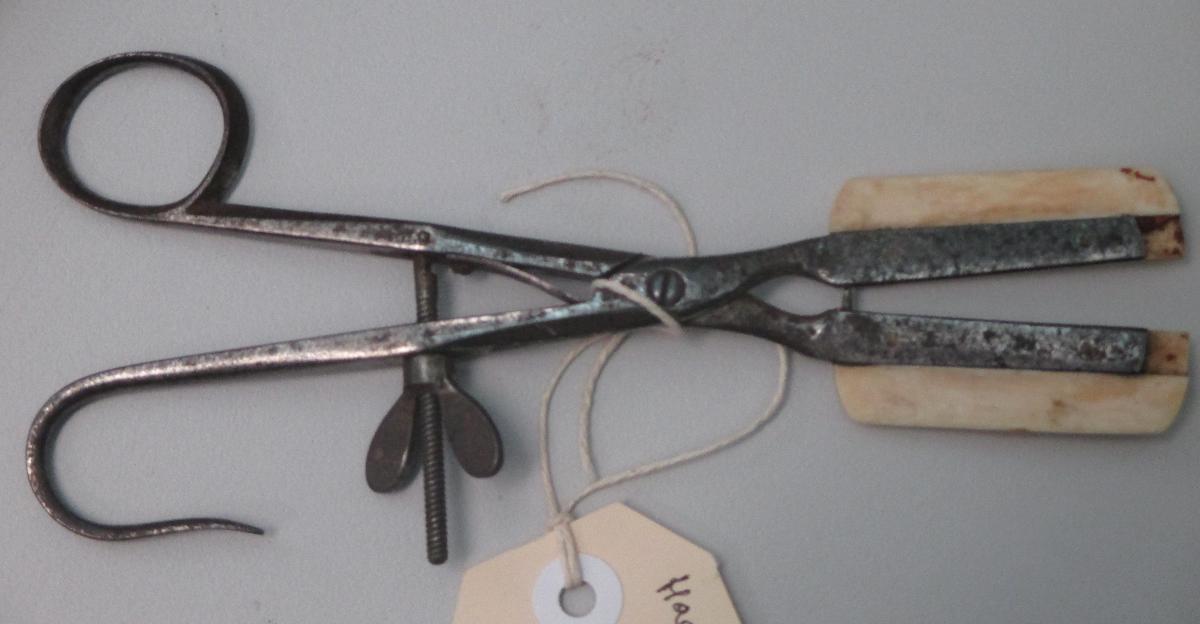Curator's Corner - Mysteries of the Medical Building
An explosion in the school
If you look closely at the timber framing surrounding the display case opposite the male toilet on Level 3 in the Mayne Medical Building you will see scars left by an explosion which also demolished the door to what was once a Pathology Department research room. Over time, the room had been used for storage and in 1961 it was assigned to a student undertaking a research project on platelet adherence. The pathology Department purchased a new microscope for the student, John Pearn, to complete the project. The cupboards in the room had also long been used for storing chemicals.
Early one Monday morning in 1961 John Pearn received a telephone call at home from the Head of Department, Professor Canny, asking him to come to the Medical School as there had been an explosion at the School. On his arrival he found the Fire Brigade and the Police were in attendance. The windows and the door to the room had been blown out leaving the scar on the timber surround of the display case opposite.
In former years an embedding material used in the Pathology Department was a solution of nitrocellulose dissolved in equal parts of alcohol. Tissue was impregnated with this solution prior to cutting on the microtome to make microscope slides.
It transpired that a bottle of this solution had been stored in a cupboard in the room that was subsequently assigned to John Pearn to undertake his project on platelet adhesiveness. This bottle apparently was the cause of the explosion.
The new binocular microscope and much other equipment was destroyed in the explosion.
The Marks Collection
I have recently uncovered a set of caption cards which supported an exhibition of instruments prepared by Dr AH Marks. These were exhibited in the school in the early 1950s and were possibly associated with the exhibition prepared for the 1950 British Medical Association meeting which was held in Brisbane. It is known that Dr Marks was one of the organisers of a group of doctors wishing to re-invigorate interest in medical history. Dr AH Marks died in 1954.

Mayfield House at Hamilton
The Medical School is bounded by Herston Road and Bramston Terrace. Henry Bramston was a registrar of the Queensland District Court. His brother John was Attorney General and a friend of the Premier of Queensland Sir Robert Herbert. Together John Bramston and Robert Herbert developed a farm of many acres which became the suburb of Herston. The name Herston was made of the first three letters of Herbert and last four of Bramston. John was a tall man with a red beard who began building his home “Mayfield” at Hamilton. Next door to Mayfield lived Mr Robert Little who was Queensland’s first solicitor. The second wife of Mr Little was Miss Bramston who was the sister of John and Henry Bramston.
However, before “Mayfield” was completed, John sold the house, with its 22 acres to Mr. R. R. Smellie of Smellie and Company, Iron mongers, with a foundry in Alice Street in the City. By 1898 the firm had changed direction to importing and had built a warehouse in Edward Street for the business. The heritage listed warehouse still stands bearing the Smellie name. In 1958, a 16 perch block of bitumen covered land that lay between Smellie’s warehouse and the “Industrial High School for Boys” which stood on the corner of Edward and Alice Streets. This was the school “Quadrangle” which was play space, cricket net, Cadet Q store and drill area for the Cadets.
At least three students of Industrial High School for Boys have connections with the Medical School: Professor of Anaesthetics at Texas University Professor Malcolm Orr, (Dr Aldyth Love’s brother); Dr Denis Costigan, GP and Royal Flying Doctor in Charleville in Western Queensland; and the Curator of the Marks Hirschfeld Museum.
Mr Smellie sold off some of the land, and completed “Mayfield” which is said to have included exquisite iron work in the fire places and mantles. Mr Smellie also moved, and in 1898 let “Mayfield” to Dr Ernest Sanford Jackson, the Medical Superintendent of the Brisbane Hospital and strong advocate for the development of a Medical School for Queensland. For three years, Dr Jackson had the benefit of the iron mantle pieces embossed with fruit and flowers, produced by Mr Smellie’s workers.
